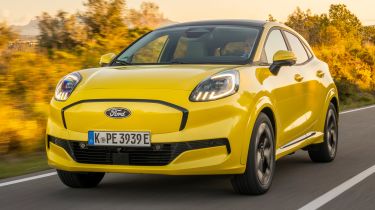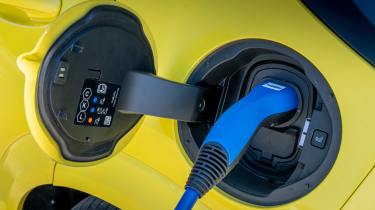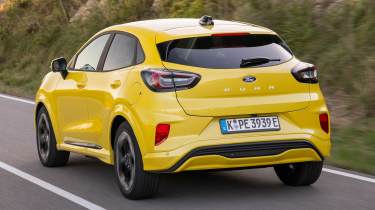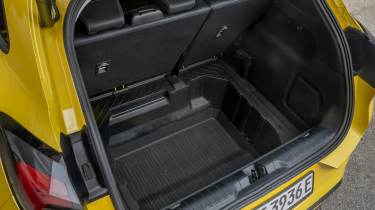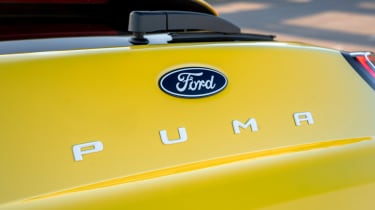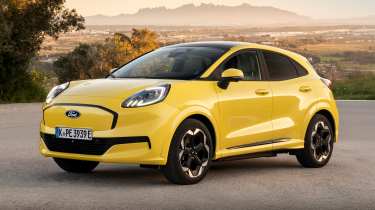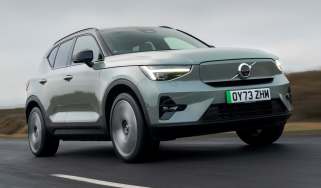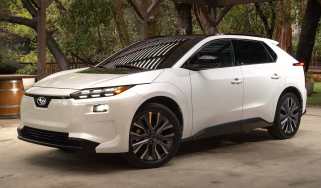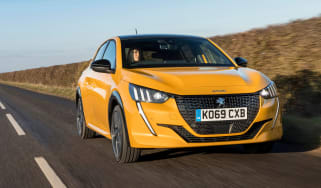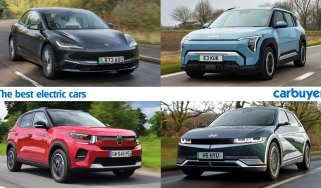Ford Puma Gen-E review – a small electric SUV playing catchup
“The electric Puma Gen-E builds on everything we like about the standard Puma, but it feels a bit late to the EV party”
Pros
- More boot space than the standard Puma
- Well priced
- Good to drive
Cons
- Disappointing range figure
- Limited leg and headroom
- Rivals’ interiors feel more modern
Verdict – is the Ford Puma Gen-E a good car?
The Ford Puma Gen-E builds on everything we like about the standard Puma, including its great driving feel, but adds low running costs and eco-friendly credentials to the recipe. The problem is that six years on from the Puma’s launch it’s a little late to the game, and rivals based on dedicated EV underpinnings offer better range and feel a lot more fresh in terms of design. That said, many will like the Puma Gen-E based on its approachable familiarity alone.
Ford Puma Gen-E models, specs and alternatives
The Ford Puma Gen-E is the electric version of the brand’s most popular car in the UK, the Puma small SUV. While the brand’s Explorer and Capri models are large and expensive, the Puma Gen-E presents the entry-way into EV ownership in the company’s line-up.
The Puma has proven itself an absolute hit amongst buyers thanks to its simple formula as a high-riding car sitting on the now-discontinued Ford Fiesta’s underpinnings, but while rivals such as the Vauxhall Mokka have long been offered with electric power, the Puma has not. That’s now changed, though, and the good news is that it starts from just under £30,000, meaning it’s more competitively priced than the Mokka Electric, too.
 Top 10 best electric SUVs – the ones to buy in 2025
Top 10 best electric SUVs – the ones to buy in 2025
That said, the game has moved on greatly in the time since the standard Puma launched, and plenty more electric cars have arrived in that time that undercut this new electric Gen-E, so it feels like the brand is playing catch up. Vauxhall itself has the Frontera Electric, which starts from just over £26,000, and there’s the closely-related Citroen e-C3 Aircross starting from just over £23,000 in electric guise.
More reviews
The Puma Gen-E is offered with a front-mounted motor that supplies it with 166bhp, which is about the same power figure as the petrol-powered car, so don’t expect it to offer the sort of breakneck performance we’ve come to expect from some EVs. It’s paired with a 43kWh battery pack which is good for a range of up to 234 miles on a charge – that’s also far from groundbreaking and a result of having based this EV on an existing platform intended for petrol and diesel models, while rivals like the Kia EV3, Skoda Elroq and Volkswagen ID.3 are based on dedicated EV platforms.
| Trim levels | Power options |
|
|
Range, charging & running costs
| Pros | Cons |
|
|
The Ford Puma Gen-E is built on the existing petrol-powered Puma’s underpinnings, so that means it was never intended as an EV from the start, whereas many rivals have been designed on EV-specific underpinnings. For that reason, range figures aren’t particularly game-changing, although most buyers that stick to shorter trips around town should be happy with the maximum 235 miles on a charge.
Rivals built to be EVs from the ground up have much more impressive range figures, and more battery options. The entry-level Kia EV3, for example, will do up to 270 miles on its 52kWh battery, while a larger 81kWh battery will keep you going for 345 miles.
Charging speeds are rated at a maximum of 100kW, which means you could top up the Puma Gen-E’s battery from 10-80% in around 23 minutes at a compatible public charger.
| Model | Battery size | Range |
| Ford Puma Gen-E | 43kWh | 235 miles |
How efficient is the Ford Puma Gen-E in the real world?
Ford claims efficiency figures for its Gen-E of around 4.7 miles per kWh, which is pretty impressive, and we were able to achieve 4.3miles per kWh, so the figures aren’t far off in real-world driving. We achieved that figure in a mix of around-town driving, driving on country lanes and motorway miles. Despite that impressive efficiency, it still equates only to around 184 miles on a charge, where rivals will realistically do around 200.
What will the Ford Puma Gen-E cost to insure?
Insurance groups for the Puma Gen-E are rather impressive, because it only sits in group 19. That’s higher than the standard petrol range does, spanning groups 12 to 17, but less than the hot Puma ST, despite a similar power figure to that car.
Electric motor, drive & performance
| Pros | Cons |
|
|
One area where the standard Puma impresses is in driving feel, and we’re happy to report that aspect has been carried over the Puma Gen-E. Though its 166bhp power figure isn’t far off that of the Puma ST, Ford decided to keep the more comfortable suspension setup from the standard Titanium models for the Gen-E. The Puma Gen-E is a great deal heavier than the standard car, but Ford has managed to hide that well, and you’d be hard pressed to notice.
There are more comfortable small SUVs out there, but that’s not to say the Puma Gen-E is uncomfortable. We think it irons out potholes and imperfections in the road well, even if the suspension never quite settles at lower speeds.
Is the Ford Puma Gen-E good to drive in town?
The Puma Gen-E’s suspension can feel a little fidgety around town, and the steering a little vague. One-pedal driving is possible, which can make around-town driving much easier because you don’t need to brake – letting off the accelerator slows the car down quickly, while recuperating energy and putting it back into the battery. One bugbear about this system is that you have to navigate through several menus to activate it.
Is it good to drive on long journeys?
The Ford Puma Gen-E is comfortable at higher speeds, which makes it nice to drive on a motorway, although the limited range might be a dealbreaker if you plan to do frequent longer journeys. While there’s plenty of shove at lower speeds, the Puma Gen-E’s power does seem to trail off at cruising speeds.
Is it good to drive on B-roads?
We certainly wouldn’t consider the Puma Gen-E a hot or even warm small SUV, but one modern Ford trademark is the brand’s ability to make even its everyday models fun to drive. It’s better on a B-road than its rivals because it feels particularly nimble through the bends. There’s loads of front-end grip and the car is very communicative for the driver, inspiring confidence.
| Model | Power | 0-62mph | Top speed |
| Ford Puma Gen-E | 166mph | 8 seconds | 99mph |
Carbuyer notes
“The Puma Gen-E’s balance is nose-heavy and this gives it a rather exploitable feel in the bends, just like the petrol-powered Puma and Fiesta before.” Alastair Crooks, senior news reporter
Interior & comfort
| Pros | Cons |
|
|
The Ford Puma Gen-E’s interior is largely the same as that of the petrol version, with just a handful of specific additions for the EV. Trim levels are completely separate, though, with Select and Premium versions on offer.
The Puma Gen-E’s interior is fairly conventional, but that might be part of the appeal for some. Ford doesn’t want to alienate its buyers with something completely wild and out-there, though the gear selector and handbrake are newly relocated to the steering column, freeing up space on the centre console for added cupholders and a wireless charging pad. The downside is that it fails to feel special or hi-tech when you compare it to new rivals on the scene offering a higher-quality feel and modern design, like the Kia EV3.
Is the Ford Puma Gen-E’s infotainment and navigation system easy to use?
The Puma Gen-E’s infotainment system is the same one you’ll find in the standard petrol Puma, so it runs Ford’s SYNC4 software. It’s very easy to use – everything is where you’d expect it to be onscreen and everything is responsive and snappy to use. The downside is that the sat nav system is laggy and overly simplistic. The good news is that Apple CarPlay and Android Auto can be used, and we recommend one of these systems for navigation.
As with the facelifted petrol versions of the Puma, many of the Puma Gen-E’s functions have been relegated to the infotainment, which – while it may make the dash look less cluttered – makes things like turning on the climate control or tweaking the audio much less intuitive to do. We wish Ford had retained more physical controls.
Is the Puma Gen-E well equipped?
Ford sells the Puma Gen-E in two trim levels and unlike those offered in the petrol Puma, these are called Select and Premium. Entry-level Select models offer everything you’d conceivably need, including 17-inch alloy wheels, that 12-inch infotainment display, 12.8-inch digital driver’s display, wireless smartphone charging and handy tech like cruise control, lane-keep assist, a rear-view camera and rear parking sensors, and LED headlights with auto high beam.
Gen-E Premium models get a few added niceties, most attractive of which are the upgraded B&O sound system and powered tailgate, but it’s a shame heated front seats, a heated steering wheel and a heated windscreen are optional extras in Premium – especially since the latter used to be a Ford staple. At around £2,000 it seems like a lot more for not that much extra kit.
What options should you choose on the Ford Puma Gen-E?
A panoramic sunroof, heated seats, steering wheel and windscreen are all optional extras on the Puma Gen-E. You can also opt for 19-inch alloy wheels, but we’d steer clear of these as we reckon they would make the ride too uncomfortable. You can also equip the Gen-E with a Driver Assistance pack which comes with adaptive cruise control with lane centring, a blind spot monitor and 360-degree parking camera.
Key features | |
|
Select
|
Premium (Select plus…)
|
Boot space, practicality & dimensions
| Pros | Cons |
|
|
The Ford Puma Gen-E is one of the smaller SUVs on sale in this segment, and that means it’s not the roomiest inside. Headroom and space up front is pretty good, but it’s in the back where things get worse, because the floor is raised to accommodate the battery, meaning your knees come up high and headroom is also compromised.
There are two ISOFIX points on the outer rear seats, which will come in handy if you have a couple of small children and need to install child seats. In the boot there’s also a handy 12-volt power socket for powering accessories.
The new centre console that the Puma Gen-E gets offers some storage space underneath, plus there are cubby holes under the central armrest and the door bins are large, too. While it’s good that there are lots of storage spaces in the Puma, it’s pretty average in this department for the class.
| Size comparison | |||
| Model | Length | Width | Height |
| Ford Puma Gen-E | 4,186mm | 1,805mm | 1,536mm |
| Kia EV3 | 4,310mm | 1,850mm | 1,570mm |
| Skoda Elroq | 4,488mm | 1,884mm | 1,654mm |
| Vauxhall Mokka Electric | 4,151mm | 1,791mm | 1,534mm |
Does the Ford Puma Gen-E have a big boot?
One nice advantage to the electric Gen-E version of the Puma compared with the petrol-powered car is that Ford has actually freed up more boot space. There’s 523 litres to play with, which is more than the Kia EV3, Skoda Elroq and Vauxhall Mokka Electric. The Gen-E’s boot space figure includes Ford’s 143-litre ‘Gigabox’ under the boot floor – lower the rear seats and you free up 1,283 litres of space. Under the bonnet, there’s a 43-litre frunk which is a handy space to keep the charging cables or a toolkit.
| Boot space comparison | |
| Model | Boot space |
| Ford Puma Gen-E | 523 litres |
| Kia EV3 | 460 litres |
| Skoda Elroq | 470 litres |
| Vauxhall Mokka Electric | 310 litres |
Reliability & safety
| Pros | Cons |
|
|
Ford performs pretty poorly in our Driver Power customer satisfaction surveys, and in 2024 it came in a lowly 30th out of 32 manufacturers, ahead only of MG and Fiat. The brand’s highest scores came in the mpg and running costs section, where it placed in a still-unimpressive 21st.
Reliability seems better than average, with 20.8% of Ford owners reporting an issue with their car within the first year. That compares with 24.3% of Kia owners and 23.7% of Skoda owners. Ford also beat Vauxhall, although with 21% of its owners reporting an issue in the first year, the difference was marginal.
How safe is the Ford Puma Gen-E?
When the Ford Puma was crash-tested in 2022, Euro NCAP awarded it a four-star safety rating. That rating is a little out of date now because the testing protocol has become more stringent since. It’s unclear whether the new Gen-E electric variant will be tested independently of the petrol car.
What is the warranty on the Ford Puma Gen-E?
While a three-year/unlimited-mile warranty used to be the standard in the industry, it’s starting to seem a little lacklustre by modern standards. In contrast, brands like Kia offer cover for up to seven years of 100,000 miles, while Hyundai provides cover for five years with no mileage cap.
Should you buy a Ford Puma Gen-E?
We think the Ford Puma Gen-E is a welcome addition to the Puma range, allowing Ford’s smallest SUV to compete with the growing slew of EVs on the market, but it just seems a little late to the party in many respects.
The Puma Gen-E’s range figure lags behind rivals which were designed to be electric from the outset, which does dent its appeal somewhat.
Still, the Puma Gen-E is well priced, and there are some welcome improvements over the petrol car including more boot and storage space, and some people will like how familiar the Puma Gen-E is to get on with, building on many of the successes of the existing petrol car.
What is the Carbuyer pick of the Ford Puma Gen-E range?
We don’t think it’s worth springing for the Premium model, given that the extra kit it comes with doesn’t feel necessary, and it costs almost £2,000 extra. It’s best to stick with the Select trim as it comes with everything you really need.
Ford Puma Gen-E alternatives
The Ford Puma Gen-E is a little late to the game, but now at least it can go head to head against direct rivals like the Vauxhall Mokka Electric. As well as electric versions of some familiar rivals, the Gen-E competes with a host of dedicated electric models from the likes ofSkoda and Kia.
- Vauxhall Mokka Electric
- Kia EV3
- Skoda Elroq
- Hyundai Kona Electric
- Vauxhall Frontera Electric
- Citroen e-C3 Aircross
- Peugeot E-2008
- Alfa Romeo Junior
- Volvo EX30
How we tested the Ford Puma Gen-E
We tested a left-hand drive example of the Ford Puma Gen-E in Spain in April 2025.
